![]()
![]()
![]()
Use LEFT and RIGHT arrow keys to navigate between flashcards;
Use UP and DOWN arrow keys to flip the card;
H to show hint;
A reads text to speech;
41 Cards in this Set
- Front
- Back
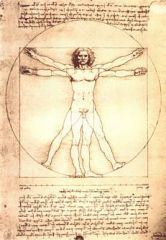
|
Style: High Renaissance City: Milan Art form: drawing *Artist: Leonardo Da Vinci *Title: Vitruvian Man *Date: Late 15°century (c. 1490 ) *Materials: ink on paper *Importance: Evidence of Da Vinci's interest in anatomy. Showing his refutation of Ancietn Roman writer Vitruvius, who wrote the human figure could be the base for a perfect circle and square. Encompasses and surpass classical knowledge, observing life and nature, challenging a current belief. |
|
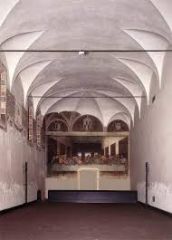
|
Style: High Renaissance City: Milan *Artist: Leonardo Da Vinci *Title: Last Supper *Date: Late 15°century (1495-1498 ) *Technique: Tempera and oil on plaster *Importance: Painted on the wall of the refectory area. (symbolic to the purpose of the monastic community)Piece is a life story capturing the moments when jesus tells his companions during he last seder meal that one of them will betray him. Each individual presents a unique emotion in their character. Deciples arranged in four groups of three, Judas, Peter and John one of the triads all play an important role in Jesus' life. Experimentation of the use of media in the piece. Used oil paint on damp plaster with tempera, fresco fell apart quickly. Use of rich chiaroscuro and one point perspective. |
|
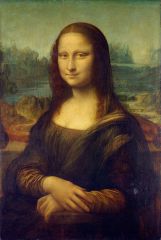
|
Style: High Renaissance City: Florence *Artist: Leonardo da Vinci *Title: Mona Lisa *Date: early 16° century (1503-1506) *Materials: oil on panel *Importance: Most famous work, believed to be an image of 24 year old Lisa Gheradini del Giocondo, wife of a Florentine merchant. Solid, pyramidal form of figure.Use of sfumato: applies a thin, lightly tinted varnish which creates the effect of a smokey haze. As well as Chiaroscuro. Unique expression, warm smile accompanied by cool expression. The mask-like detachment characteristic of early Renaissance portraits, shows expressive complexity and a sense of psychological presence. He achieves a new level of naturalism. |
|

|
Style: High Renaissance City: Rome *Artist: Michelangelo *Title: Pieta *Date: early 16° century (1500 ) *Material: marble *Importance: early work. Commissioned by French cardinal and installed as a monument for St. Peters. Virgin appears very young, which is a manifestation of her inner virtue. Scale of Christ and virgin disproportionate, the size of her lap is exaggerated to compensate for the fact that she is holding her fully grown son. The smooth pyramidal shape which is done by very slight exaggeration, a ability of michelanglo's, of Mary. |
|
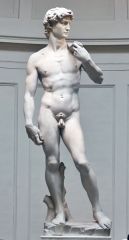
|
Style: High Renaissance City: Florence *Artist: Michelangelo *Title: David *Date: Early 16th century (1501-1504 ) *Material: marble *Importance: Statue embodies the antique ideal of the athletic nude, the emotional power in the face is new in sculpture. David appears to be preparing himself psychologically for the danger ahead. David is a symbol of Florentine, who just recently fought forces of Milan, Siena and Pisa with success. God-like in scale. Very technically challenging because it was an inherited incomplete work of very thin marble. Classical influence of controposto in the body. |
|
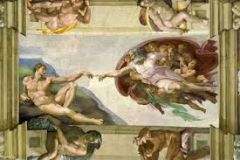
|
Style: High Renaissance City: Rome *Artist: Michelangelo *Title: Creation of Adam *Date: early 16° century (1511-1512 ) *Technique: fresco *Importance: Moment when God charges the languorous Adam with the spark of life. Adam's body, arm and profile almost mirror God, who's image he has been created in. Emerging under God's other arm is Eve, looking at her future companion. |
|

|
Style: Mannerism *Artist: Michelangelo *Title: Last Judgment *Date: Mid 16th century (1536–1541) Location: Sistine Chapel *Technique: Freso *Importance: On the altar wall of the sistine chapel. Very different feeling than the ceiling. Is an exhibition of the human body, shows skills of foreshortening, lightness and irregular position of the human body. Still see the influence of Greek/Roman Earth's dead crawl out of the tomb, higher up the angel and the damned fight. Throngs of saints and saved rise up to heaven. |
|
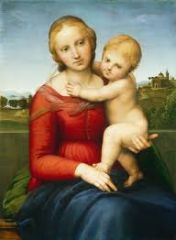
|
Style: High Renaissance City: Florence *Artist: Raphael *Title: Small Cowper Madonna *Date: early 16th century (c. 1505) *Materials: oil on panel *Importance: Sfumato use. Illustrates and intimate interaction between the Madonna and child, influence of Leonardo. |
|

|
Style: High Renaissance City: Rome *Artist: Raphael *Title: School of Athens *Date: early 16° century (1510-1511) *Technique: fresco *Importance: summarizes the ideals of the Renaissance papacy in its grand conception of harmonious arranged forms and rational space, as well as the calm dignity of the figures. The composition inspired by the shape of the room it is placed in. Room is filled with important figures of thought at the time, divided down the middle (left=philosophy) (right=science). Center has Plato on the left, motioning towards the heavens as a source of philosophy, Aristotle on the right, motioning hand down to the natural world as science. Poses of body and building create dynamic unity that is characteristic of High Renaissance Art. |
|
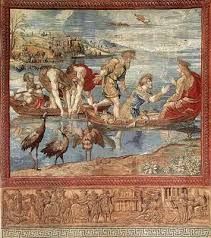
|
Style: HighRenaissance *Design Workshop: Raphael and assistants City: Rome *Weaving Workshop:Shop of Pieter van AelstCity: Brussels *Title: MiraculousDraught of Fishes on the Sea of Galilee *Date early 16th century (1519 ) *Materials: Tapestry. Wool and silk with silver-gilt wrapped threads *Importance: Shows the apostle Peter kneeling before Christ, all muscle bound, straining figures. 3 cranes in background symbolizes watchful eye of the pope. |
|
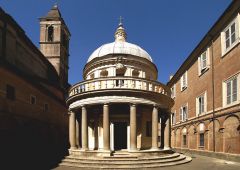
|
Style: High Renaissance *City: Rome *Architect: Bramante *Title: Tempietto *Date: Early 16th century (1502) Design: central plan *Material: marble *Importance: |
|
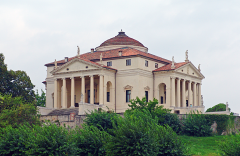
|
Style: High Renaissance *Region: The Veneto (region around Venice) *Architect: Pallaido *Title: Villa Rotunda *Date: Late 16°century (1566 to 1571) Design: central plan *Materials: stucco-covered brick *Importance: Maximized vistas of the countryside by placing a porch elevated at the top of a wide staircase for each building. Inspired by Roman pantheon- a circle inscribed inside a larger square with staircases projecting from each of its faces. Choices of the central dome secularized the dome and initiated a tradition of domed country houses. |
|
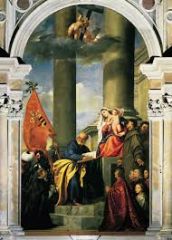
|
Style: High Renaissance City: Venice *Artist: Titian *Title: Pessaro Madonna *Date: Early 16th century (1519-1526) *Materials: Oil on canvas *Importance: Grandeur of the scene, columns, staircase, displays the power and glory of the Pesaro. Builds up layers of pure colour, chiefly red, white, yellow and black. Use of red creates a triangular structure for your gaze. Seeing a shift in the materials, now oil on canvas because the climate makes the walls unsuitable. This allowed for looser brushstrokes and thick vs thin application and allows for a much larger scale.
|
|

|
Style: Mannerism *Country: Italy *Architect and Artist: Giulio Romano *Title: Palazzo del Te *Date: Early 16th century (1524-1534 ) Purpose: Pleasure villa *Importance: trying to pull the same effect of irregularity. The clouds are carved to create an illusion of hair, the building id square but each side is slightly different. Isolated blocks appear as if they may be about to drop. |
|
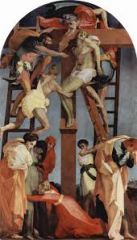
|
Style: Mannerism Country: Italy *Artist: Fiorentino *Title: Deposition *Date: Early 16th century (1521) *Materials: Oil on panel *Importance: Figures are elongated, figures are in tense, uncomfortable, almost dangerous positions. Dramatic lighting, rough harsh blending, really careful colour choice and set against a threatening sky. Use of lino serpentine, common mannerist technique composition. |
|
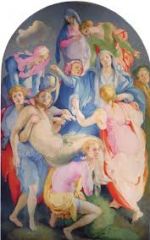
|
Style: Mannerism City: Florence *Artist: Pontormo *Title: Deposition *Date: Early 16° century (1525-1528) *Material: Oil on panel *Importance: Ignores the pyramidal formula for lina serpentine. Figures are in complex, swirling positions. Effect of ignoring the centre. gives rhythm of bright and strange colours, shadows rendered in pure hues which contrast with miminal dreary background. Cangiante modeling No show off of perspective skills. |
|
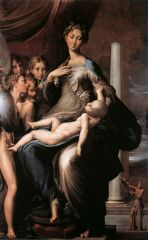
|
Style: Mannerism Country: Italy *Artist: Parmigianino *Title: Madonna of the Long Neck *Date: Mid 16th century (1534-1534) *Material: Oil on panel *Importance: Has the principal hallmarks of Mannerist style -ambiguous composition which enhances visionary quality. -shadowy ground and sky give little sense of space, which the figures push in and out of the piece. -charged emotionally with odd poses and drastic shifts -very unique use of pastel colours -multidirectional gaze Shows trademarked elongated of human form which introduce disorder and confusion |
|
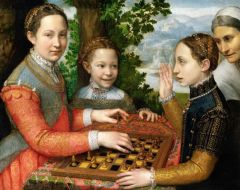
|
Style: Mannerism City: Florence *Artist: Sofonisba Anguissola *Title: Lucia, Minerva and Europa Playing Chess *Date: Mid 16th century (1555) *Materials: Oil on canvas *Importance: A new example of subject matter of the intimate domestic family scene. |
|
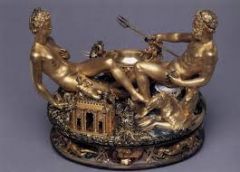
|
Style: Mannerism Country: France *Artist: Cellini *Title: Salt Cellar of Francis I *Date: Mid 16th century (c. 1543 ) *Materials: Gold and enamel with ebony base *Importance: A status symbol, status of an individual based on the closeness of the seat to the salt dish. Influenced by Michealanglo Void in the centre (mannerist) Mannersit in the ideal of beautiful woman, and the designing of the plyth as part of the piece. |
|
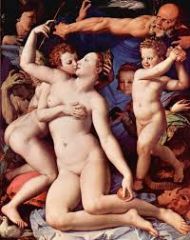
|
Style: Mannerism City: Florence *Artist: Bronzino *Title: Allegory of Venus and Cupid and Folly *Date: Mid 16th century (c 1545) *Materials: Oil on panel *Importance: Mannerist in all aspects. Seven figures, two masks, and a dove interweave in an intricate, claustrophobic formal composition. As individual images Manneristic poses and forms are displayed. Closer up shows bizarre exotic imagery. |
|
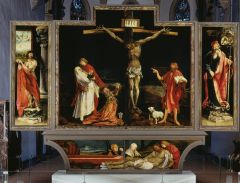
|
Style: Northern High Renaissance Country: Germany *Artists: Hagenauer (sculpture) and Grunewald (painter) *Title: Isenheim Altarpiece *Date: Early 16th century (c 1500-1515) *Materials: Oil on panel and painted and gilt lime wood *Importance: at this point Catholicism is untouched by any oner religion. Use of the late gothic arch, multi-winged, made for the chapel of a monastic hospital which served skin disease (lepersy). Different configurations based on the times. Closed wings: Cruxifiction scene with patron saints of diseases See a profound difference between Northern and Italian of how the emotion is handled, there is an admiration of violent sensation and emotion. 1st set of wings open: Annunciation scene 2nd set of wings open: Painting only on the wings, left side: meeting btw St. Anthony and St. Paul, a moment of serenity in a sickly landscape. right side: delusion of hospital patients |
|
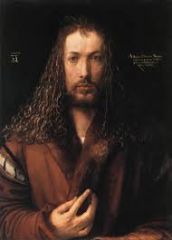
|
Style: Northern High Renaissance Country: Germany *Artist: Durer *Title: Self Portrait *Date: Early 16th century (1500 ) *Materials: Oil on panel *Importance: Bring Italian ideas of portrayal and status of artists. Attempting to idealize himself to an ideal ratio. Posed traditionally used in N art for Christ. Clothing indicates statement |
|

|
Style: Northern High Renaissance Country: Germany *Artist: Durer *Title: Adam and Eve *Date: Early 16th Century (1504) *Technique:Engraving *Importance: Very cutting edge technique of engraving into a metal plate with acid. A distinction of classes btw woodblock prints, these were meant for connoisseurs and collectors. Taking ancient Roman nude to influence Christian subject matter. Use of mathematics in determining proportions Northern qualities in capturing of texture and detail as week as some northern philosophy (animals rep. medieval medical ideas of temperament) |
|
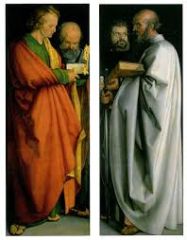
|
Style: Northern High Renaissance Country: Germany *Artist: Durer *Title: Four Apostles *Date: Early 16th century (1526 ) *Materials: Oil on panel *Importance: An attempt to prove that religious art still had its place in the Lutheran religion. Depicts the four evangelists writing books of new testament. Italianate in drapery and the monumentality of figures. |
|
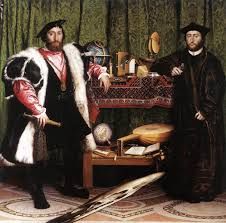
|
Style: Northern High Renaissance Country: England *Artist: Holbein the Younger *Title: Ambassadors *Date: Early 16th century (1533 ) *Material: Oil on panel *Importance: Iconic of what is happening at the time. Depicts 2 humanist scholars, items are symbolic of political situation of the current globe exploration to the North Americas and Africa. Contains what appears to be disfigured shape however when viewed at the right angel is a skull, "anamorphosis". |
|
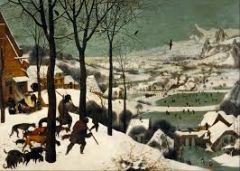
|
Style: Northern High Renaissance Country: Flanders *Artist: Pieter Bruegel the Elder *Title: Return of the Hunters *Date: Mid 16th century (1565 ) *Materials: Oil on panel *Importance: Pioneer of the genre of landscape and everyday peasant life. Has no symbolism or religious meaning, developing a taste for a new kind of realism that from free from a literary or moral backstory. Perspective detaches viewer from the scene. |
|
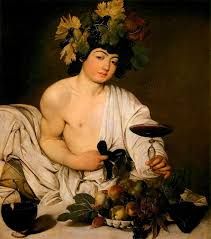
|
Style: Baroque City: Rome *Artist: Caravaggio *Title: Bacchus *Date: Late 16th century (1595-1596) *Materials: Oil on canvas *Importance: Close up, loss of idealization, the model has a farmers tan and dirt under his nails, capturing the everyday reality. |
|
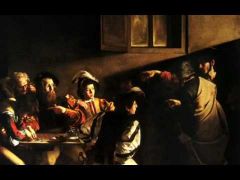
|
Style: Baroque City: Rome *Artist: Caravaggio *Title: Calling of St Matthew *Date: Late 16° century (c. 1599) *Materials: Oil on canvas *Importance: Light becomes very symbolic. Shifts focus from saints to sinners, Jesus is barely visible other than the hand which points at the accountant who will be declared a saint. |
|
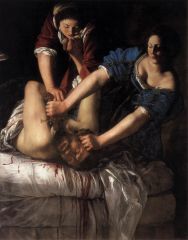
|
Style: Baroque Country: Italy *Artist: Gentileschi (female) *Title: Judith Slaying Holofernes *Date: Early 17th century (1614-20) *Materials: Oil oncanvas *Importance: Continuation of her tendency to paint strong, sexually wronged woman from the old testament. The story depicts is of a widow who saves the city by killing anAssyrian general, who allows her into her home to have sex. They then brought the head back and displayed in on the gates, striking so much fear into the assyrians that they fled. |
|
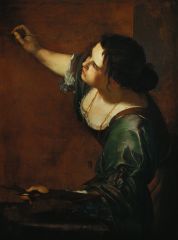
|
Style: Baroque City: Florence *Artist: Gentileschi *Title: Self Portrait *Date: Early 17th century (1638-1639 ) *Materials: Oil on canvas *Importance: Painted in the act of painting, may be meant to a way in which to represent the artist as the allegory of painting, in the way in which she was dressed and her hair. Body creates a diagonal force, the background is unfinished, used cagiante shadowing (use of different colours for shadows) and is very technically strong |
|
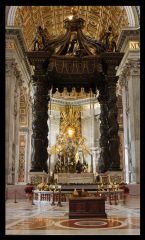
|
Style: Baroque City: Rome *Artist: Bernini *Title: Baldacchino *Date: Early 17th century (1624-1633 ) *Material: Gilt bronze, hollow casting *Importance: A canopy standing above the old entrance to the catacombs where it is believed that St. Peters was buried. The twisting pillar shape was inspired from old St. Peters (solomonic shape). |
|
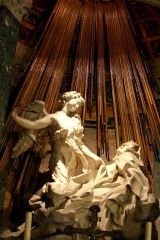
|
Style: Baroque City: Rome *Artist: Bernini *Title: St Theresa of Avila in Ecstasy *Date: Mid 17th century (1645-1652) *Materials: Marble and mixed media *Importance: Sexual depiction of spiritual ecstasy. St. Theresa is struck by an angel, clothing is ripped, placed in an elaborate multimedia area. Bernini designed the entire space it existed in. Watching on are figures of the commissioners family put in balconies in various positions and activities. |
|
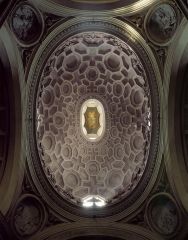
|
Style: Baroque *City: Rome *Architect: Borromini *Title: Interior dome of San Carlo *Date: Mid 17th century (1638-1667) *Importance: Extremely elaborate geometry, the only material is various shapes of white stucco. Inspired by early christian mosaic work. Very illusionistic, gives the sense that every layer is floating on others without physical support. Also very architecturally challenging because of the choice of an oval shape. |
|
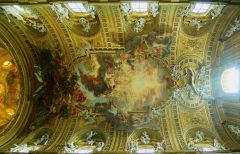
|
Style: Baroque City: Rome *Artist: Gaulli *Title: The Triumph of the Name of Jesus and the Fall of the Damned *Date: Late 17th century (1672-1685 ) *Materials: Fresco with stucco figures *Importance: shows a seamless transition between painting and moulded architectural elements. The heavens are receding, the letters IHS (Christ's insignia), the damned are tumbling down from the ceiling. This is a common and popular Baroque theme. |
|
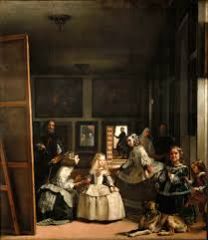
|
Style: Baroque Country: Spain *Artist: Velazquez *Title: Las Meninas (The Maids of Honour) *Date: Mid 17th century (1656) *Materials: Oil on canvas *Importance: Use of the art of misdirection, meant to appear like life taking place in front of us. Slice of intimate life, a mirror in the piece hints that the royal couple is being painted in the scene and we view it from their perspective. Also a portrait of the daughter and princess with her maids. Use of a la prima- painting wet on wet, blending on the canvas. Allows for the ability to see more individual brush strokes. Up close the clarity of the image breaks down. |
|
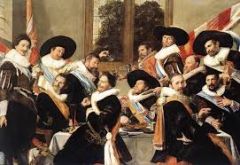
|
Historic Period: Dutch Golden Age Style: Baroque *Artist: Hals *Title: Officers of the Haarlem Militia Company of Saint Adrian *Date: Early 17th century (1627) *Materials: Oil on canvas *Importance: Use of a la prima Very challenging to tackle a group scene in which each person must be given similar space without being incredibly static. Depicts a believable interaction, put the scene at an annual banquet which allows for the addition of colour to break up the plainer calvinist clothing. |
|
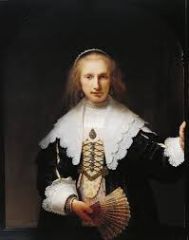
|
Historic Period: Dutch Golden Age Style: Baroque *Artist: Rembrandt *Title: Agatha Bas *Date: Mid 17th century (1641) *Materials: Oil oncanvas *Importance: A wedding portrait of an extremely wealthy |
|
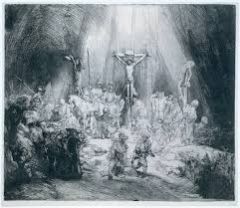
|
Historic Period: Dutch Golden Age Style: Baroque *Artist: Rembrandt *Title: Three Crosses (showing first state) *Date: Mid 17th century (1653) *Technique: Dry point and etching *Materials: Ink on paper *Importance: Very painterly |
|
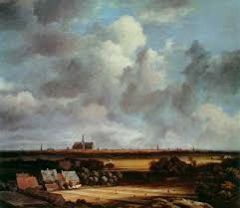
|
Historic Period: Dutch Golden Age Style: Baroque *Artist: Van Ruisdael *Title: View of Haarlem from the Dunes at Overveen *Date: Late 17th century (1670 ) *Materials: Oil on canvas *Importance: shows the dutch value of their land and well as the common use of the large blue sky in their landscapes. |
|
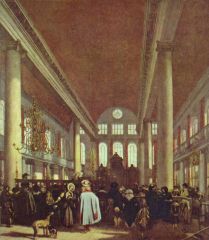
|
Historic Period: Dutch Golden Age Style: Baroque *Artist: De Witte *Title: Portuguese Synagogue *Date: Late 17th century (1680) *Materials: Oil on canvas *Importance: Shows the presence of jewish culture. Shows a simpleness in the interior of the structure seen in a church. |
|
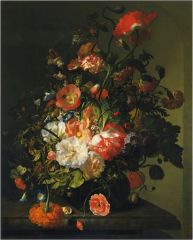
|
Historic Period: Dutch Golden Age Style: Baroque *Artist: Ruysch *Title: Flower Still Life *Date: Early 18th century (exact date unknown) *Materials: Oil on canvas *Importance: This was a common theme and a specialty of Ruysch. Creates a fictional bouquet from various botanical studies combined later on. |

